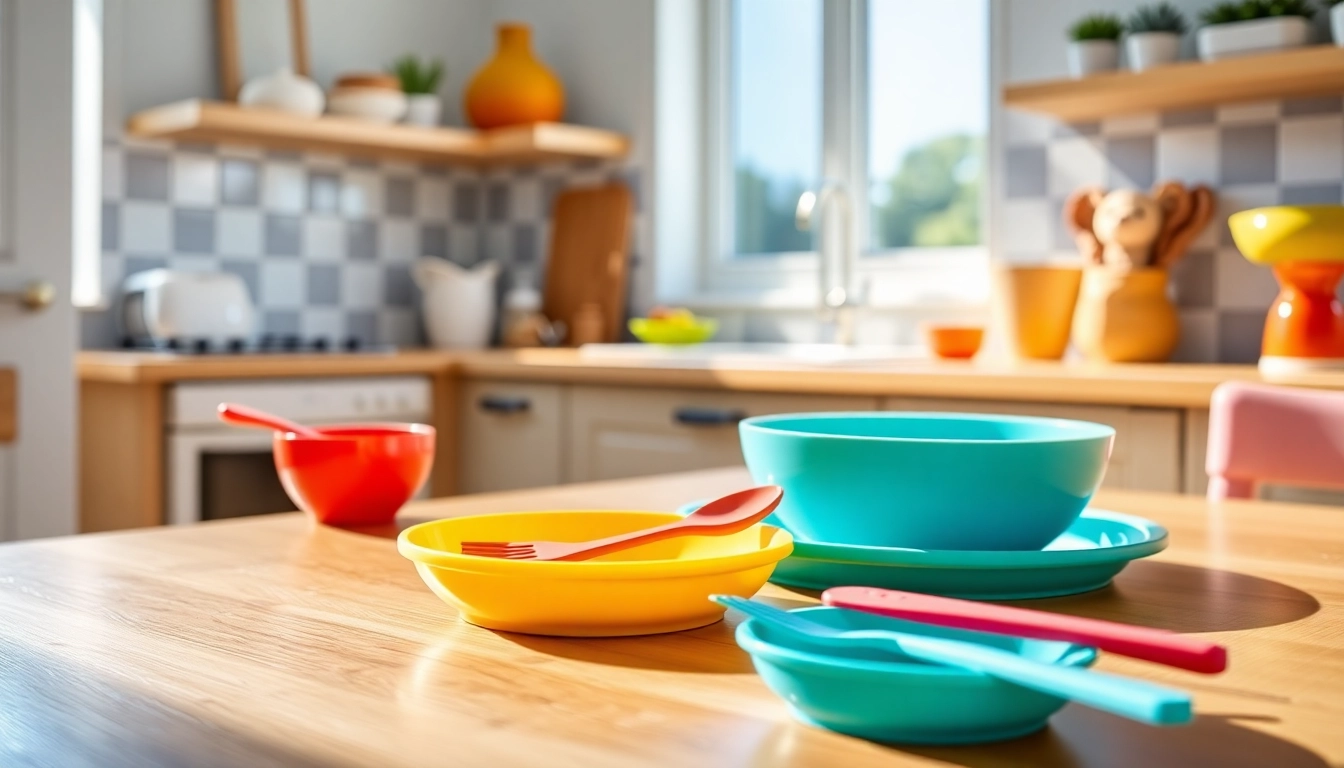Understanding the Benefits of Safe Silicone Baby Tableware
When it comes to introducing your little one to solid foods, choosing the right tableware is a crucial step toward fostering independent eating habits in a safe and healthy manner. Among the various options available, safe silicone baby tableware stands out as an optimal solution, blending safety, functionality, and durability. This comprehensive guide explores why silicone is the ideal material for baby tableware, how to select the best products for your child’s needs, and effective strategies to incorporate these utensils into everyday feeding routines.
Why Silicone Is the Ideal Material for Baby Tableware
Non-Toxic and Safe for Babies
Silicone is a non-toxic, food-grade material that is inherently safe for infants and toddlers. Certified silicone products, especially those labeled as BPA-free and free from ftalates and other harmful chemicals, ensure that no toxic substances leach into food, safeguarding your child’s health. Made in accordance with strict safety standards, these utensils minimize the risk of allergenic reactions or chemical exposure that can occur with plastics containing harmful additives.
Flexibility and Resistance
Unlike glass or ceramic, silicone is highly flexible and resistant to breakage, making it an excellent choice for the active, curious nature of young children. Its durability ensures that tableware can withstand drops, bites, and frequent use without cracking or chipping, thus maintaining safety over time.
Temperature Tolerance and Easy Maintenance
Silicone maintains its integrity across a wide temperature range, from freezing to oven-safe temperatures, allowing for versatile use—whether serving cold, warm, or hot foods. Additionally, silicone is dishwasher safe, easy to sterilize, and resistant to stains and odors, ensuring long-lasting hygiene and convenience.
Health and Safety Advantages of Certified Silicone Products
Rigorous Certification Standards
High-quality silicone for baby tableware adheres to stringent certification standards such as FDA or LFGB approval. These certifications guarantee that the silicone used is free of BPA, phthalates, lead, and other toxic substances, offering peace of mind to parents concerned about their child’s health.
Environmental Considerations
Silicone is a sustainable alternative to disposable plastics due to its reusability and longevity. Properly maintained silicone tableware can be used for years, reducing waste and environmental impact while maintaining safety and functionality.
Allergy and Sensitivity Management
For children with sensitivities or allergies, certified silicone’s inert properties eliminate worries about allergic reactions caused by residual chemicals or additives present in other materials. This makes silicone a universally safe choice for all infants and toddlers.
Comparison Between Silicone and Other Baby Feeding Materials
Silicone vs. Plastic
While plastic offers affordability and variety, it often contains BPA, phthalates, or other harmful chemicals, even in so-called “child-safe” plastics. Silicone provides an inert, chemical-free alternative, ensuring safer feeding experiences.
Silicone vs. Glass and Ceramic
Glass and ceramic are heavy and fragile, posing risks of breakage and potential injury. In contrast, silicone’s flexible and shatterproof nature makes it safer for children, especially during active mealtimes.
Silicone vs. Metal
Metals like stainless steel are durable and non-toxic but may pose risks of hot or cold retention, which can lead to burns or discomfort. Silicone’s insulating properties help maintain food temperature and provide a comfortable, safe grip for babies.
Choosing the Right Safe Silicone Baby Tableware Set
Key Features to Look for in Silicone Baby Plates and Bowls
When selecting silicone tableware, prioritize products that are certified with safety standards such as LFGB or FDA approvals. Look for items with non-slip bases—like suction cups— to prevent tipping, and ensure that all edges are soft and rounded for comfort and safety. Features like removable compartments, vibrant colors, and ergonomic designs encourage self-feeding and make mealtime engaging.
Sizes, Shapes, and Designs for Different Ages
For infants just beginning to eat solids, small, shallow bowls are ideal, while larger, compartmentalized plates suit toddlers developing autonomy at mealtime. Shapes inspired by fun themes—such as rainbows or animals—can captivate young children, fostering a positive association with tableware. Additionally, adjustable utensil sizes and ergonomic handles contribute to proper motor development.
How to Select Safe and Durable Silicone Utensils and Accessories
Ensure that utensils like spoons and forks are ergonomically designed for small hands, with smooth edges and a balanced weight. Silicone accessories such as placemats, bibs, and snack containers should also adhere to safety certifications. Durability is key; products should withstand frequent dishwashing at high temperatures and exposure to saliva and food residues without degradation.
Effective Tips for Introducing Silicone Tableware to Your Child
Gradual Transition from Bottles to Silicone Tableware
Transitioning to silicone tableware can be seamless if done gradually. Start by offering small portions in silicone bowls during snack time, alongside familiar utensils. Engage your child by demonstrating how to use new items, making mealtime a playful experience that builds confidence and curiosity.
Engaging Kids with Colorful and Fun Designs
Children are naturally attracted to bright colors and fun shapes. Select silicone tableware with vibrant hues or playful patterns to stimulate their interest and encourage independent eating. Incorporate storytelling or games to make mealtime enjoyable, helping children associate positive feelings with their utensils.
Cleaning and Maintenance for Long-lasting Use
Proper cleaning is essential for maintaining hygiene and prolonging the lifespan of silicone tableware. Most silicone utensils are dishwasher safe—although hand washing with mild soap is preferable for delicate designs. Avoid abrasive scrubbers that may damage the surface. Regular inspection for signs of wear or damage ensures continued safety and functionality.
Innovative Uses and Practical Applications of Silicone Baby Tableware
Versatility in Snack Time, Meals, and On-the-Go
Silicone tableware is highly adaptable, suitable for breakfast, lunch, dinner, and snack times. Compact, lightweight, and shock-absorbent, silicone utensils are perfect for picnics, travel, or daycare. Their flexibility allows for creative packaging, such as collapsible containers for space-saving storage.
Integrating Silicone Tableware in Different Feeding Environments
Whether at home, in a restaurant, or outdoors, silicone tableware ensures safety and convenience. Use suction bases to keep plates stable on various surfaces, and opt for spill-proof lids or covers for transport. These features facilitate confidence during on-the-move feeding, reducing messes and fostering independence.
Creative Packaging and Gift Ideas for New Parents
High-quality silicone tableware makes an excellent gift for new parents. Presenting a set in an attractive package, possibly accompanied by matching utensils or a reusable bag, can be both practical and thoughtful. Customize sets with vibrant colors and adorable designs to appeal to both parents and children.
Measuring Success: Ensuring Safe and Satisfying Baby Feeding Experiences
Monitoring Child’s Comfort and Preference
Pay attention to how your child interacts with the tableware. Comfort, ease of use, and visual appeal influence willingness to eat independently. Adapt choices based on feedback—such as trying different shapes, sizes, or colors—to find what resonates best with your little one.
Assessing Material Safety Standards and Certifications
Always verify that products display appropriate safety labels and certifications. Trusted brands like Bèbeboom prioritize certification and transparency, ensuring each item meets rigorous safety standards. Quality assurance directly correlates with the well-being of your child during feeding time.
Gathering Feedback to Improve Your Feeding Routine
Encourage your child to express preferences and observe their reactions. Regularly evaluate whether the utensils are ergonomic, safe, and engaging. Incorporate feedback into your purchasing decisions, and stay updated with innovations in baby tableware to enhance your child’s eating experience continually.



